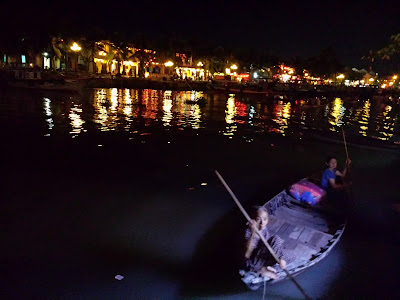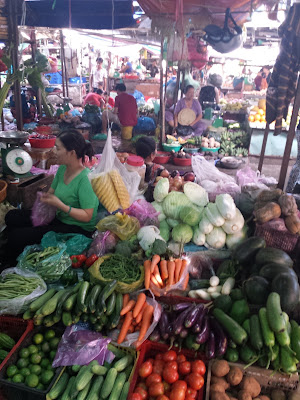We went on a three week journey to explore the hidden charms -- took the train from Ho Chi Minh City to Hue, the ancient capital city of Vietnam. From Hue, we drove to Hoi An, a rich cultural heritage site; celebrated the auspicious mid-Autumn Festival with the local folks, and took a boat trip to the Cham Island before flying back to Ho Chi Minh City.
Hue
We walked along the Song Huong River (Perfume River) and over the Truong Tien Bridge into the ancient Citadel, where the entrance to the royal Imperial City came into view. We past by the aircrafts and tank (from the American War) that led us into the city wall.
Across the moat of the city wall, lined old shop houses where the local folks live a laidback lifestyle, operating small eateries and cafes along the sidewalks outside their homes.
The Dong Ba market is also accessible by boat -- the largest market place that trades in almost everything from A to Z. We took a dragon boat across the Song Huong River to experience the local lifestyle -- the women folks sorting out and cleaning the local produce, under the shade of the tree by the riverbank.
Dragon boats and private boat houses anchored on the banks of the Song Huong River.
A leisurely cruise along the Song Huong River.
Life along the bank of the Song Huong River.
We disembarked here and visited some quaint villages.
The view from the Train
The train journey took us about 26 hours from Ho Chi Minh City to Hue. On this leg of our journey, we took the air-conditioned overnight express train with a 4-berths cabin. An absolutely interesting experience to talk to the local folks on the train and listen to stories about their lives and families.
The stretch of coastal journey from Danang to Hue provided two hours of endless breathtaking coastal scenes, that runs along the South China Sea, snaking around the cliffs with ocean views on the one side and lush vegetation forest mountains on the other side, through tunnels and hills, via the Hai Van Pass.
The cheerful train attendants helping passengers to alight and board the train at the several major stops.
The road trip from Hue to Hoi An
The leisurely drive took us about three to four hours. We stopped in Nam O to enjoy the popular "Goi Ca", soaked in the coastalscape before arriving in Hoi An Old Town.
Lang Co Beach
We got our hotel to arrange a private car with driver to take us to Hoi An that turned out to be one fun-filled day -- the road trip brought us to places we wanted to go instead of the typical stopover attractions. On our final day in Hoi An, we arranged for the same driver to take us to the Danang airport for our flight back to Ho Chi Minh City.
Hoi An
This cultural city is situated on the coast of the South China Sea, in Quang Nam Province, and is listed by the UNESCO as a World Heritage Site.
Hoi An was known as Champa city, once a thriving trading harbour port that brought tremendous wealth to the people, that attracted Chinese from other provinces as well as the Japanese and Dutch that eventually made this place their home.
The Old Town is now a bustling touristy place that comes to life usually after 3:00pm. Most tourists come here in hope to get their clothes tailored within a few days while some will order tailored-made leather shoes or other leather accessories. It helps to bring your own sample pieces to show them exactly how you want them done, and negotiate first.
I was curiously distracted by the large number of local folks that took the morning daily public boat from the harbour port, across the Thu Bon River, to Kim Bong Village. Tashi and I hopped on one of the boats to find out what surprises may be found there.
Kim Bong Wood Artisan Village
This quaint, laidback village is not only famous for its fine wood artisan craft, but it is also into shipbuilding.
A shipyard -- building and repairing boats. I was pleasantly surprised to find skilled craftsmen working away on several large-sized fishing wooden boats, using traditional techniques.
The riverbank
These boats ply the river several times daily. They ferry the local folks and their bikes from the harbour port to Kim Bong Village and back.
Having a go at crossing the monkey bridge.
At this wood artisan crafts shop, a team of artisans were busy chiseling away at some figurines, furniture and all kinds of woodcraft works on the work floor, strewn with wood dust and wood chips. I was completely taken in by the strong, sweet, sarsi-like fragrance from these carved wood.
There are also several big scale woodcraft shops in this village, catering not only to local businesses but also to tourists visiting their shops, looking to buy some souvenirs.
An apt name, Kim means 'gold' and Bong means 'floating' -- the village that is blessed with a thriving woodcraft trade, a wealth of good fortune indeed.
The Enchanting Cham Islands
Known as Cu La Cham, this island is made up of a cluster of eight small islands. An absolutely picturesque and pristine paradise that one could simply opt to do just nothing, and watch the local folks going about with their daily lives or go out to seek adventures -- the marine life just takes your breath away. It is such a colourful, aquatic world filled with an abundance of diversity of fish, mollusks (some, not seen elsewhere), lobsters, a collection of sea grass, marine algae and coral reefs...and so much more. Then, there is lush, forest and mountains to explore.
The best part of it all is -- no one is allowed to bring plastic bags to the islands! Everyone, including the island folks have to upkeep environmental friendly practices.
Hon Lao is the largest and the only inhabited island.
Fishermen mending fishing lines and nets. I was captivated by everything that went on, in and around this island!
A cool basket boat repair workshop.
Basket Boats (Thung Cai) -- this is not a showcase for tourists. The island folks use them, and one can request to have a go at paddling it!
I was curious and checked out what they brought back from the day's catch -- one crab, sea urchins and some fish.
All island folks, young and old alike, enjoy fishing -- the catch of the day!
The menfolks are into a game of domino, while taking their afternoon break.
All speedboats and the local ferry depart Cu Dai pier no later than 9:00am. Speedboats will leave the main island, Hon Lao before 2:00pm. The ferry departs the main island at noon. The sea water was calm in the morning, but by the afternoon when we left, it got so rough that most of us were drenched in sea water on the way back to Cu Dai harbour.
We paid for a round trip on a private speedboat at VND400,000 per person. The ticket included a seafood meal, and about an hour out at sea to swim and/or snorkel at a popular spot. We opted out of the fixed programmes, explored the island at our leisure.
From June to about August, this region is a diver's paradise, with about over 20 metres visibility. Most ideal for snorkelling too!Special thanks to Duc and Xinh! I would love to make a trip back here!
Mid-Autumn Festival in Hoi An Ancient Town
We stayed for a week, celebrated one of the most colourful Mid-Autumn Festival held over the two nights. We explored the winding alleyways to catch a glimpse of the lifestyle of local folks working away in small shop houses, busy at sewing clothes or making local snacks. The Old Town is listed as a UNESCO World Heritage Site, bustling with tourists.
The Tra Que Herb and Vegetable Village -- the small village located a few kilometres northeast of Hoi An is the place to experience the soul of the farmers' lives and how they help sustain green farming, using the natural resources found in the lagoon in Tra Que -- the algae in the water that the farmers use to feed the land, nourishes the herbs and vegetables that provide a crisp, natural sweetness to the greens grown and supplied throughout Hoi An that I have had the fortune to enjoy.
Ho Chi Minh City Alley Walks
When there is a quaint alley in the local neighbourhood, there will always be a small, colourful market close by; with street vendors peddling their wares or selling food.
We went on walking tours in and around the alleys in the local neighbourhoods, in District 3 where Vietnamese live and in District 2 where most of the expatriates live. On another occasion, I took a solo alley walk in an area that was not zoned under any of the Districts that I found to be the most localized Vietnamese experience!
In District 3, our starting point was at a hotel. We walked along the main road and turned into a street that led us into a maze of tangled network of narrow alleyways. Every turn into an alley was like a colourful wonderland filled with small vendors cooking up one of the best yummy street eats imaginable!
We went on walking tours in and around the alleys in the local neighbourhoods, in District 3 where Vietnamese live and in District 2 where most of the expatriates live. On another occasion, I took a solo alley walk in an area that was not zoned under any of the Districts that I found to be the most localized Vietnamese experience!
In District 3, our starting point was at a hotel. We walked along the main road and turned into a street that led us into a maze of tangled network of narrow alleyways. Every turn into an alley was like a colourful wonderland filled with small vendors cooking up one of the best yummy street eats imaginable!
Alley walks meandering through lanes is such a stimulating experience to watch a completely different side of the local folks going about their daily lives -- the noise disappear, the pace of life is slower, the doors of shops and homes are opened to let us have a glimpse of the happenings...
A hip looking barber shop!
A close-knit community of people and their hanging garden runner plants, hanging over the balcony and onto the floor below, beside the street vendor nearby.
In and around Chinatown -- a boy relaxing on the push cart, while his mother sells local snacks.
An ancient temple in Ho Chi Minh City.
This has been an amazing journey, having had the good fortune to immerse in the local culture, to savour the food, and mingled with the friendly local folks. We travelled to Ho Chi Minh city, took the overnight train journey to Hue. After Hue, we drove to Hoi An; made several stops along the route -- stopped at Nam O, a fishing village town to taste the popular goi ca, took a brief detour to check out Lang co beach before making a one week stopover in Hoi-An to soak up the rustic charms of the Cham Island and quaint villages, and finally flew back to Ho Chi Minh city for our final week there to explore the local neighbourhood alleys.
Thinking of the next trip back perhaps to the Cham Islands!
Special thanks to Gary and June for letting us bunk in at your lovely home during our week stay in Ho Chi Minh City!(Travelled in September/October 2015)
















































































